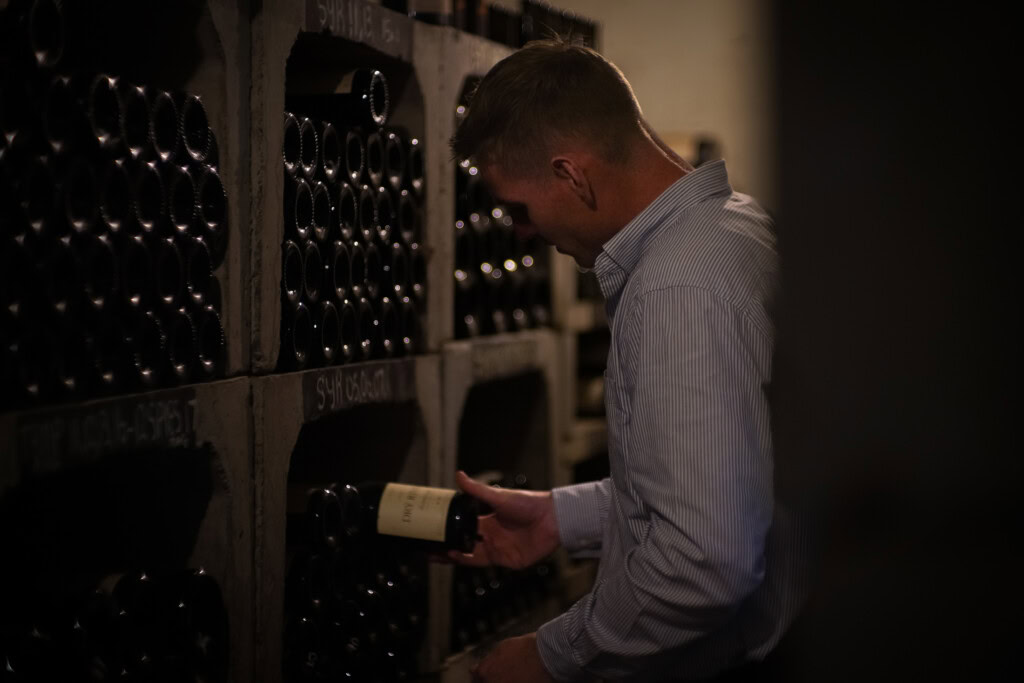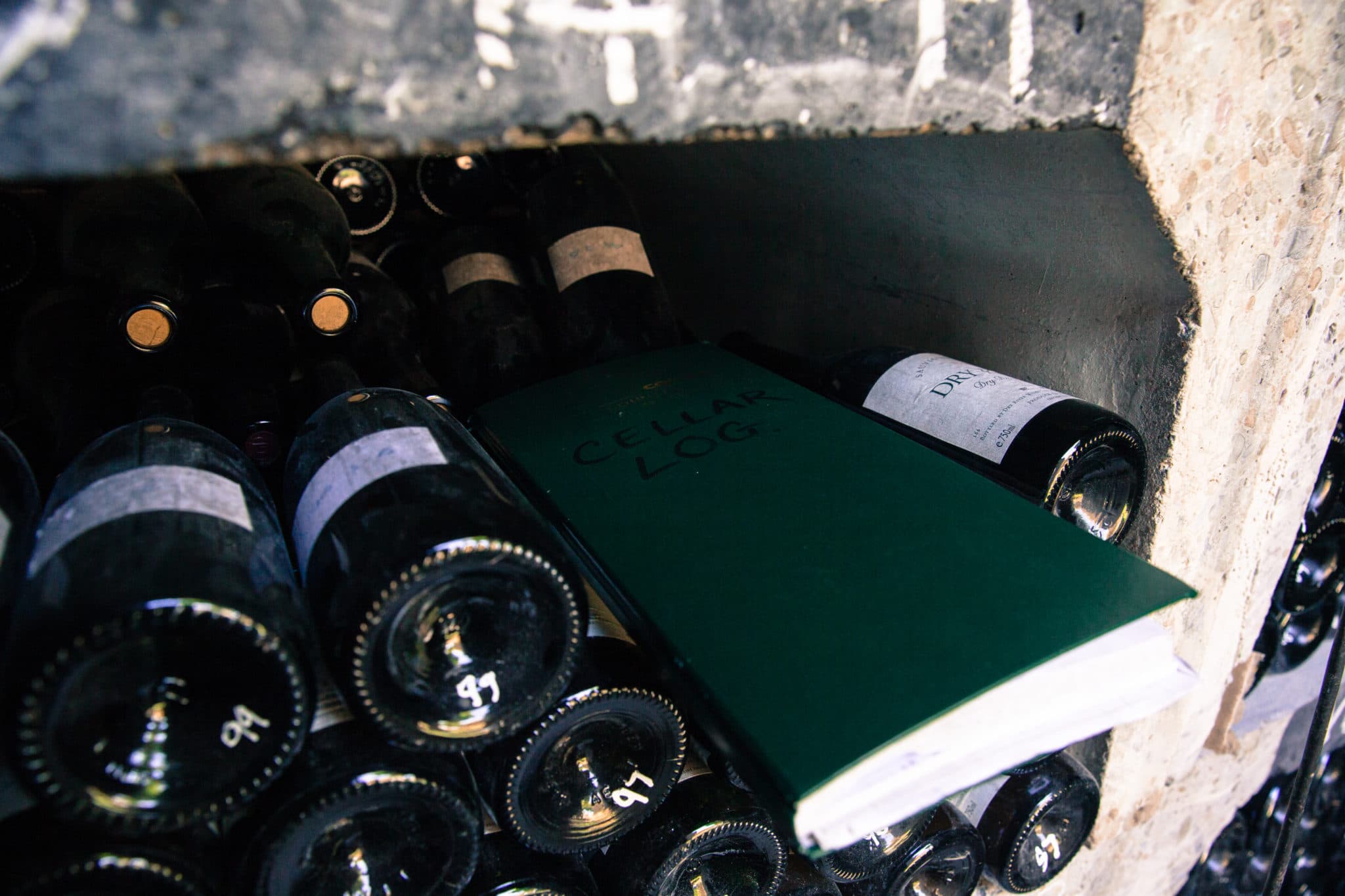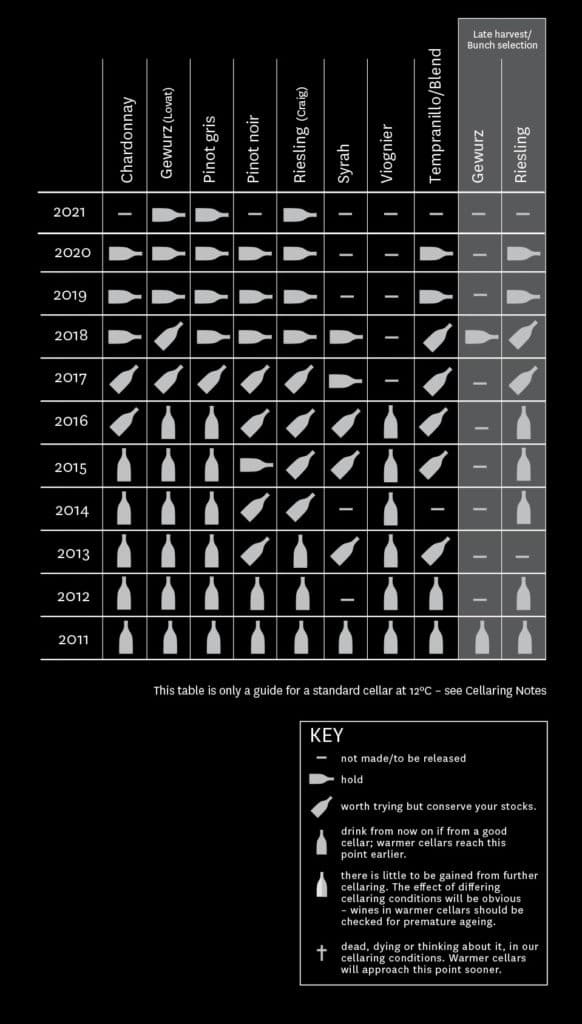Be aware that our wines can ‘go into a tunnel’ somewhere between six months and two years after release. During this time the wine can be quite unrewarding, but be patient because it can blossom later and confound earlier impressions and predictions. A second dip can occur between 4 & 6 years when the wine can start to look tired then may well emerge looking refreshed and in an interesting new phase for the next few years. It can be worth opening and even decanting them a few hours before serving – particularly the reds.
“ Wine maturation is an organic process which is very dependent on the conditions of cellaring ”
This guide is for a ‘standard cellar’ at 12°C. Warmer and fluctuating temperatures will age wine more rapidly and may not be as beneficial to the less robust wines and varietals. In our experience the ‘robustness’ of wines is likely to be in the order:
- Cabernet and blends
- Sauvignon blanc
- Syrah
- Riesling
- Pinot gris & Chardonnay
- Pinot noir & Gewurztraminer

Wines high in extract will tend to mature rather more slowly than the ‘average’ same varietal on this list. If you have a number of our wines and your cellar conditions are not similar to our ‘standard cellar’, you will no doubt learn how to interpret the chart in relation to your own conditions. However, a more active approach to evaluating your cellar is to note temperatures for the range of the days, between weeks and between seasons, by leaving a thermometer in a large jar of water in your cellar. It is not sufficient to observe that the cellar ‘always feels cool’ – such feelings are relative only to outside conditions. Significant fluctuations in daily or weekly temperatures tend to add to the speed of ageing commented on below, and may also increase the incidence of leakers and seepers, occasionally give examples of ATA (atypical ageing – see Aromas) and disproportionately fast ageing for laccase-containing wines (i.e. those with potential or actual botrytis). Vibration and direct light on the wine are damaging influences which should also be avoided.
| If your storage has temperature maximums of not more than… | Then your storage conditions are… |
|---|---|
| 10-15°C | good, and your wines will be at a similar stage of development to that indicated in the Cellaring Guide. Burgundians say that for proper cellaring Pinot noir must be kept in this temperature range (cf. the book Pinot noir, by A. Barr, p33). |
| 15-18°C | at these temperatures your wine could be maturing 20-25% faster than above. Nevertheless, for quality the conditions are adequate, unless you would like to pamper your wines or your cellar is large and/or valuable. The chart should still be very useful, but bear in mind that your wines will develop faster. The results will possibly be slightly less fine. |
| 18-24°C | this includes quite a few Auckland cellars. It is not ideal; differences in speed of development will be evident even with storage over 2-3 years. Plan for holding less robust wines (discussed above) no more than 3 years. Be aware a mature wine from this cellar may not be quite as good as one aged at lower temperatures. |
| 25+°C | not very good, but do note that most good wines may still benefit for up to 2 or 3 years in this cellar. Less robust wines probably should not be held beyond 2 years. Cabernet and blends, Sauvignon blanc, Fumè blanc, Riesling could benefit from longer periods, depending on the actual conditions. Avoid cellaring Pinot noir. |
General notes relating to cellared wines
Wine maturation is an organic process which is very dependent on the conditions of cellaring. Wines do not inevitably end up at a predictable quality and style, hence André Simone’s famous quote ‘there are no great wines, only great bottles.’ Nevertheless, cellars with the best possible conditions are the most likely to produce the best possible end results.
Be aware that our wines can ‘go into a tunnel’ somewhere between six months and two years after release. During this time the wine can be quite unrewarding, but be patient because it can blossom later and confound earlier impressions and predictions. A second dip can occur between 4 & 6 years when the wine can start to look tired then may well emerge looking refreshed and in an interesting new phase for the next few years. It can be worth opening and even decanting them a few hours before serving – particularly the reds.
- Ageing – premature
- wine can show maturity beyond its years, but this tends not to be such a cause for concern until the wine is past its peak – as evidenced by loss of fruit, oxidation and possible browning. If a number of wines in your cellar show such symptoms and these are in advance of expectations, a careful evaluation of your cellar conditions is necessary. If you do not wish to or cannot improve these conditions, be aware that all your wines should be drunk somewhat earlier than may be generally recommended. Wines from high-laccase vintages, e.g. ’95 and ’97, will be disproportionately affected. Premature ageing does sacrifice some potential quality. Refer to CELLARING GUIDE or consult us if you have queries.
- Aromas – unpleasant
- If you know that a wine had good typical smells when first purchased but it has developed unpleasant (sulphide) smells as it has aged, there can be several possible explanations. These include ATA (atypical ageing) which is brought on by heat – either a short period at high temperatures or warmish cellaring. ATA may affect an occasional bottle within that batch of wine, and the only way of avoiding it is to improve the cellar or storage conditions to less than 14˚C. Leaving a bottle out in bright light can also cause sulphides (“light struck”), and wines stored under screwcaps can also generate this type of smell when stored for a few years.
- Bottle Shock
- Shortly after a wine is bottled it can appear atypical, lacking fruit, becoming rather hard and angular and even tasting aldehydic. This is from the effects of filtration and possible oxidation at the time of bottling and it should recover in a few months.
- Breathing wines
- This is the practice of decorking a wine or even decanting several hours before drinking. It can help very young wines (particularly reds), more mature wines which may have developed less than pleasant smells, or slightly sprizig reds.
- Buying cellared wines
- This can be a risky proposition. It is unwise to accept an auctioneer’s assurance that they have been cellared well. Risks can be reduced by buying only the ‘robust varieties’ (see Cellaring Guide) but unless you know that the cellar was temperature controlled, purpose-built or situated within a cool even-temperatured climate, be prepared for surprises. Check the cork and ullage.
- Capsules
- Capsules may be made from many materials including plastic, metals or sealing wax. Capsules can protect the cork against cork borer but tend to have little other than a decorative function, unless they are made of wax, which probably slightly slows down the access of oxygen and is therefore an alternative for wines to be cellared for a long time, or for half bottles.
- Clarity/brilliance
- Cloudiness in a white wine can be unattractive but need not affect the flavour. In these instances it can arise from a protein instability or some other causes. Other forms of hazes in both whites and reds can arise from microbiological instability or the effects of trace metals such as iron or copper and may indicate a damaged wine. (See also Sediment/deposits.)
- Colour/hue
- This should be appropriate for the type and age of the wine. Excessive brown tints immediately call the condition of the wine to question – oxidation and premature ageing are possible. (See also Oxidation.)
- Cork borers
- These are probably similar to wood borer. Cork dust is seen on the outer surface of the cork and small holes will have been eaten into the cork. I suggest spraying a pyrethroid fly spray on the surface of the cork and then sealing it with sealing wax. If a number of bottles are affected, fumigating your cellar may be a good idea.
- Corked wines
- This does not refer to wines with fragments of cork in the bottle. The fault arises from trace flavours within the cork which result in wines with mouldy or ‘wet sack flavours’ and a loss of fruit. In borderline cases, a loss of fruit might still be evident, but the extraneous flavours will be too difficult for most to detect. Although the fault arises from the cork manufacture, most winemakers will replace the bottle. It is worth noting that we have strict Quality Assurance checks on all our corks. If it appears that two of our wines in a row show cork taint, check that the problem does not in fact arise from cellaring conditions.
- Corked Wines – return of
- If one of our wines is affected, we will provide a credit for the mail order purchase of the same wine from a later vintage. We do like to confirm the cause of the problem so, if at all possible, top up the bottle with boiled and cooled water, stopper it with the original cork in the same orientation as it was originally, and return it to us ASAP (preferably within 24 hours) with a note indicating the date of opening, for forwarding to the cork supplier. Expect no more than around 1 in 50 of recent vintages to be affected.
- Decanting
- Essential with all wines which throw a sediment, otherwise the flavours will be impaired. (See also Sediment/deposits.) Wines made for cellaring (i.e. rich in antioxidants) can look lean and hard when first opened, but access by air softens and improves the texture. Even our older white and red wines (after good cellaring) are likely to benefit from decanting a few hours in advance and our young reds in particular, can even benefit from being left to cool or in the fridge overnight.
- Half bottles
- These have the same size cork for half the volume of wine. Oxidation and ageing therefore proceed significantly faster than with larger bottles. Given the choice, buy the larger bottles for long-term cellaring. Dessert wines of very high must weight can last a long time even in half bottles.
- Lead residues
- Older wine bottles with lead capsules tend to accumulate traces of lead acetate around the mouth, and theoretically these residues may be partly dissolved when 17 pouring the wine. Wipe the top of the bottle clean before pouring such wines. Lead capsules are now phased out worldwide and Dry River has used alternative materials since 1992.
- Leakers
- If a new wine is leaking badly, return it. If it is a particularly good wine, it can be recorked. (see also Seeping Corks.) If your older wines have a tendency to leak, check your storage conditions.
- Loss of, or unusual flavours
- Had you cleaned your teeth or sucked peppermints within a few hours of tasting the wine? This can markedly alter your perception of flavours. Alternatively the wine may be ‘corked’ (see above), suffering from premature ageing (see below) or oxidation. Storing bottles of wine in sunlight (particularly in clear or lighter coloured glass) can cause flavour loss in a matter of weeks.
- Oxidation
- This can cause a drying sensation – more in the front of the mouth – which can be reminiscent of the flavour of sherry, or smell toffee-like, or cause dulled fruit on the palate. It can arise because of excessive ullage, poor cellaring, or because the wine is simply too old. Dull colour or excessive brown tints can be telltales, but don’t be confused by the effect of fluorescent light on reds, particularly lighter coloured ones. (See also Random Oxidation.)
- Random Oxidation
- Occasionally one can encounter oxidized wines which are unlike the rest of the batch from which they came. There are several possible explanations for this problem which can be found under all types of closures. If the wine is one of ours, treat it as described in Corked Wines – return of so that we can confirm the problem and give a credit for that bottle.
- Sediment/deposits
- Most sediment which settles easily is harmless and the wine should be decanted off it before serving. Allowing the sediment to mix into the wine can make a dramatic difference to the perception of quality – particularly in reds. (See also Wine crystals and Decanting.)
- Seeping corks
- If the top of the cork is damp, the wine should be drunk soon – even if there is no obvious increase in ullage. Seepage is an indication that air has had at least some access to the wine, and although such bottles are unlikely to be spoiled, this low-level oxidation will progressively dull the fruit as time goes on. If you are getting a significant number of these wines, check the temperatures and temperature fluctuations in your cellar – it may need to be improved.
- Temperature of serving
- Generally red wines are served warmer than whites. However, there are no simple rules, so be prepared to experiment or consult a good wine text. Remember that your perception of many flavours can change considerably with a change of only a few degrees celsius.
- Travel Shock
- Vibration during transport can make wine appear atypical – hard or angular and lacking fruit. It can take up to two months to recover – less if stored at low temperatures. Transporting wine at low temperatures (5–10˚C) reduces the problem. Exposure of the bottle to vibration during storage (e.g. under stairs) can have a similar effect.
- Ullage
- The ullage is the gap between the cork and the level of the wine when the bottle is vertical. As the wine grows older the ullage will increase depending on the cork and storage conditions. If the cork is actually leaking and has an excessive ullage it should be drunk as soon as possible. Older wines with excessive ullage and sound corks will tend to oxidise or deteriorate more quickly, but robust examples can still be sound with 4.5–7cm ullage. More delicate wines and most whites will show deterioration well before this. Always check the ullage of a wine and the condition of the cork before opening the bottle to determine whether it may be atypical in terms of its ageing.
- Wine crystals
- With time, some wines may deposit crystals in the bottle and on the inside of the cork. In a white wine these crystals tend to be white and in a red wine they may be affected by the colour of the wine. This is a natural deposit reflecting a lack of processing in the wine. It can be found in the most expensive hand-made wines and should not be considered a fault. It does not necessitate decanting.


